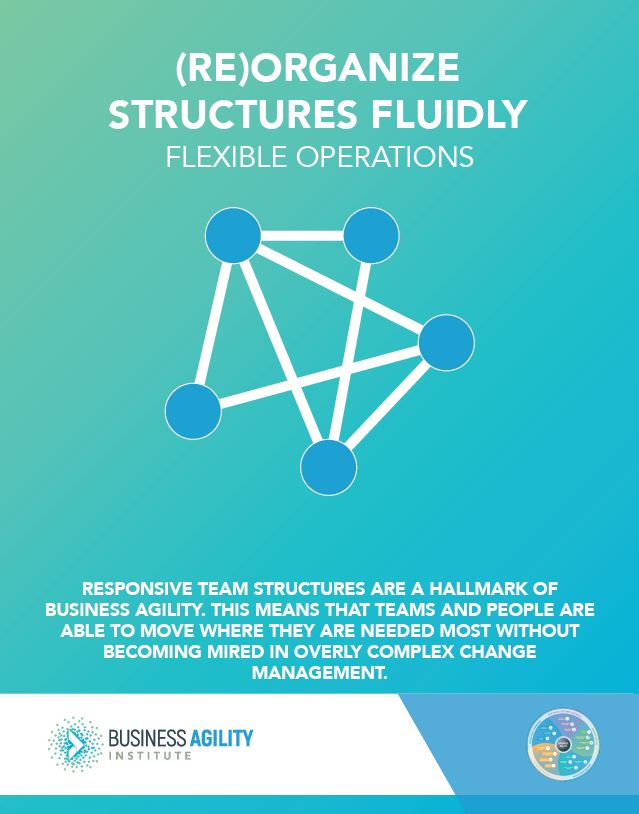Domains of Business Agility
- Responsive Customer-Centricity
- / Fiercely Champion The Customer
- / Sense & Respond Proactively
- / Integrate Diverse Ideas
- Engaged Culture
- / Cultivate A “Learning Organization”
- / Engage Transparently & Courageously
- / Embed Psychological Safety
- / Act As One
- Value-Based Delivery
- / Unleash Workflow Creatively
- / Prioritize. Prioritize. Prioritize.
- / Deliver Value Sooner
- / Seize Emergent Opportunities
- Flexible Operations
- / Adapt Strategies Seamlessly
- / Fund Work Dynamically
- / (Re)Organize Structures Fluidly
- / Balance Governance And Risk
- People-First Leadership
- / Foster Authentic Relationships
- / Empower With Accountability
- / Realize People’s Potential
Responsive team structures are a hallmark of business agility. To embrace new opportunities with ease and without disruption, you must be able to dynamically and responsively restructure parts (or all) of your organization. This means that teams and people must be able to move where they are needed most without becoming mired in overly complex change management.
Change is everywhere. Customers, competitors, markets, and environments are all constantly in motion. The result is that the pressure to change constantly builds up. Yet the fear of the unknown, change, and volatility can all keep organizations from making frequent, small, and necessary changes. And the cost is high. When they resist change until they no longer can, organizations often wind up facing enormous change efforts that waste time and creativity.
Primary Behaviors
The following 3 behaviors strongly contribute to the ability to ability to (re)organize structures fluidly.
B60: Leaders rapidly identify and secure the resources and people for new opportunities: When new initiatives are identified we can bring the work to an existing team or form a new team quickly, while ensuring they have access to all the resources they need to effectively deliver the initiative. This is done mindfully without overburdening the WIP limits of the organization or any teams, and where necessary we will stop other work to deliver on the highest value initiative. In addition, considerations of make vs buy and hire vs contract are quickly assessed and enacted.
B61: Leaders proactively adjust organizational structure and operating model to align with strategy: In other words, we don't wait. Change happens when it's needed. We don't batch change.
B62: Leaders intentionally develop staff for lateral and diagonal positions and promotions: Leaders take a long term, broad view of how their staff might serve the organization in the future. With this perspective, leaders develop and support their people not only to advance in their current area, but also to take lateral shifts and promotions in other parts of the organization.


